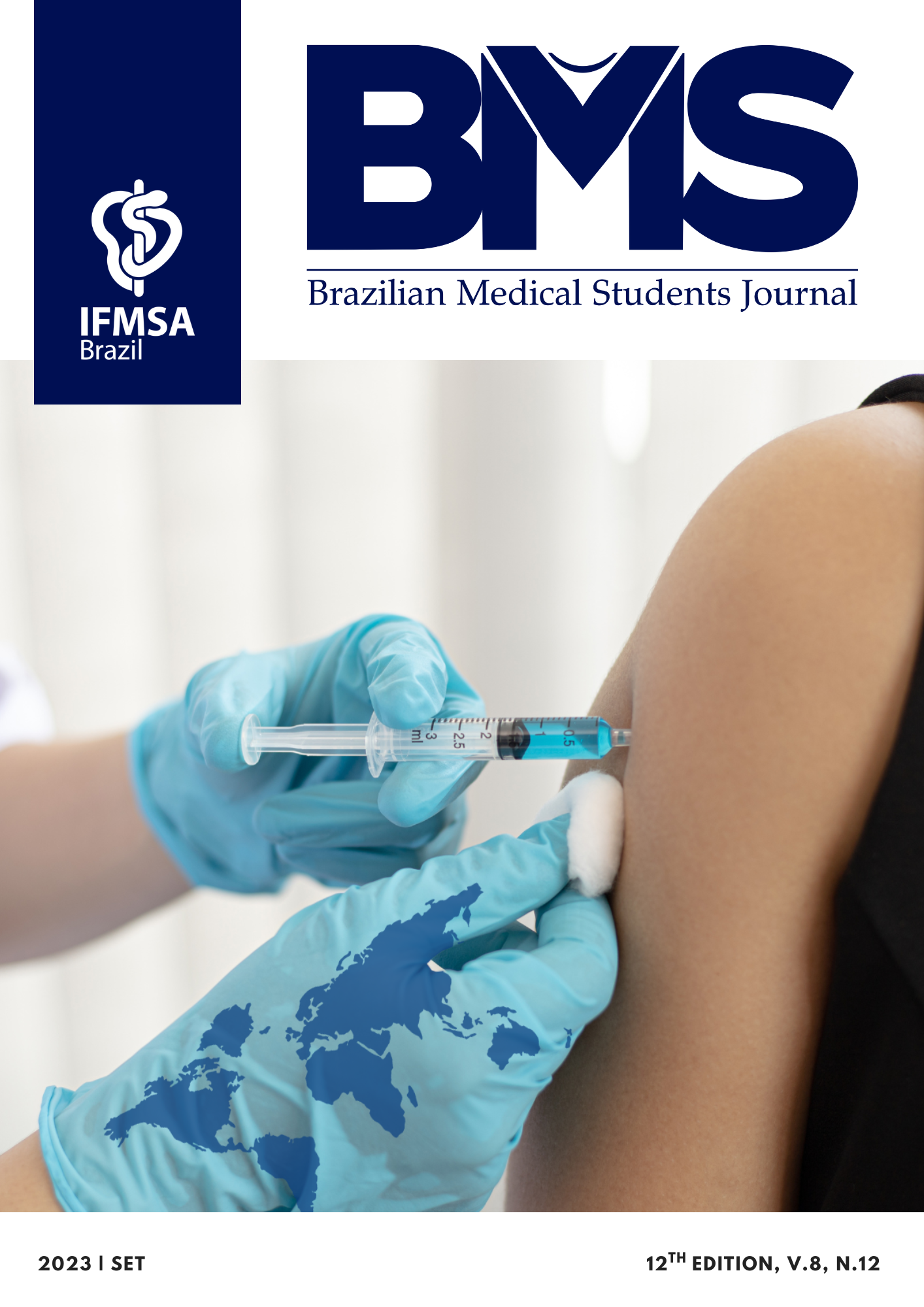Epidemiology of hospitalization and mortality rates due to ischemic cerebrovascular accident in Brazil
DOI:
https://doi.org/10.53843/bms.v8i12.323Keywords:
Ischemic Stroke, Spatio-Temporal Analysis, Risk FactorsAbstract
Introduction: Ischemic Cerebrovascular Accident (ICVA) is characterized by the occlusion of a blood vessel in the brain with interruption of the oxygen supply, being the most frequent form of stroke, representing 87% of cases. Thus, the aim of the current study is to evaluate the trend of hospitalization (HR) and mortality (MR) rates due to stroke by age group, between 2011 and 2020.
Methodology: This is a analytical, observational and retrospective study. The number of hospitalizations and deaths due to stroke was obtained from the Mortality Information System (SIM) and population data from the Brazilian Institute of Geography and Statistics (IBGE). HR and MR per 100,000 inhabitants were calculated, as well as their trends by segmented linear regression. Annual percentage changes (APCs) were obtained with 95% confidence intervals (95%CI).
Results: Brazil had 223,210 hospitalizations and 23468 deaths due to stroke in the period. HR and MR were higher according to age in all years. There was a decreasing trend for both HR (APC= -4,5) and MR (APC= -7,9) for the total population. With the exception of the age groups from 1 to 39 years old, the others had decreasing HR. While in MR, only the age group between 1 and 19 years showed a stationary trend.
Discussion: The decrease in HR and MR coincided with the period of implementation of the Hiperdia program whose objective is to link patients with systemic arterial hypertension and diabetes mellitus to health units, guaranteeing them systematic treatment which prevents risk factors modifiable factors of great impact on the occurrence of stroke.
Conclusion: It is extremely important to raise awareness of the population regarding modifiable factors for stroke, as well as the professional improvement of the service team since a shorter time for the approach is essential to avoid worse outcomes.
Metrics
References
REFERÊNCIAS
Roxa GN, Amorim ARV, Caldas GRF, Ferreira A dos SH, Rodrigues FE de A, Gonçalves MOSS, et al. Perfil epide-miológico dos pacientes acometidos com AVC isquêmico submetidos a terapia trombolítica: uma revisão integrativa / Epidemiological profile of patients affected with Ischemic Strok subject to thrombolytic therapy. Brazilian J Dev [In-ternet]. 2021;7(1):7341–51. Available from: https://www.brazilianjournals.com/index.php/BRJD/article/view/23443/18826 DOI: https://doi.org/10.34117/bjdv7n1-496
Rodrigues MDS, Santana LF e, Galvão IM. Fatores de risco modificáveis e não modificáveis do AVC isquêmico: uma abordagem descritiva. Rev Med [Internet]. 2017 Sep 29;96(3):187. Available from: https://www.revistas.usp.br/revistadc/article/view/123442 DOI: https://doi.org/10.11606/issn.1679-9836.v96i3p187-192
Friberg L, Rosenqvist M, Lindgren A, Terént A, Norrving B, Asplund K. High Prevalence of Atrial Fibrillation Among Pa-tients With Ischemic Stroke. Stroke [Internet]. 2014 Sep;45(9):2599–605. Available from: https://www.ahajournals.org/doi/10.1161/STROKEAHA.114.006070 DOI: https://doi.org/10.1161/STROKEAHA.114.006070
Al-Rubeaan K, Al-Hussain F, Youssef AM, Subhani SN, Al-Sharqawi AH, Ibrahim HM. Ischemic Stroke and Its Risk Factors in a Registry-Based Large Cross-Sectional Diabet-ic Cohort in a Country Facing a Diabetes Epidemic. J Dia-betes Res [Internet]. 2016;2016:1–9. Available from: http://www.hindawi.com/journals/jdr/2016/4132589/ DOI: https://doi.org/10.1155/2016/4132589
Marianelli M, Marianelli C, Neto TP de L. Principais fatores de risco do avc isquêmico: Uma abordagem descritiva / Main risk factors for ischemic stroke: A descriptive appro-ach. Brazilian J Heal Rev [Internet]. 2020;3(6):19679–90. Available from: https://www.brazilianjournals.com/index.php/BJHR/article/view/22269/17802 DOI: https://doi.org/10.34119/bjhrv3n6-344
Carvalho VP. Perfil clínico-epidemiológico de pacientes com acidente vascular cerebral. Saúde e Desenvolv. 2019;13(15):50–61.
van Alebeek ME, Arntz RM, Ekker MS, Synhaeve NE, Maaijwee NA, Schoonderwaldt H, et al. Risk factors and mechanisms of stroke in young adults: The FUTURE study. J Cereb Blood Flow Metab [Internet]. 2018 Sep 23;38(9):1631–41. Available from: http://journals.sagepub.com/doi/10.1177/0271678X17707138 DOI: https://doi.org/10.1177/0271678X17707138
Hathidara MY, Saini V, Malik AM. Stroke in the Young: a Global Update. Curr Neurol Neurosci Rep [Internet]. 2019 Nov 25;19(11):91. Available from: http://link.springer.com/10.1007/s11910-019-1004-1 DOI: https://doi.org/10.1007/s11910-019-1004-1
Benjamin EJ, Blaha MJ, Chiuve SE, Cushman M, Das SR, Deo R, et al. Heart Disease and Stroke Statistics—2017 Update: A Report From the American Heart Association. Circulation [Internet]. 2017 Mar 7;135(10). Available from: https://www.ahajournals.org/doi/10.1161/ DOI: https://doi.org/10.1161/CIR.0000000000000491
CIR.0000000000000485
De Brito PVMM, Silva JVP, Da Silva MVM, Barros LAF, Oliveira V da S, De Sousa AF, et al. Estudo descritivo da evolução dos gastos pelo Sistema Único de Saúde com in-ternações hospitalares por Acidente Vascular Cerebral em Goiás, 2010-2019. Rev Eletrônica Acervo Saúde [Internet]. 2021 Jan 23;13(1):e5543. Available from: https://acervomais.com.br/index.php/saude/article/view/5543 DOI: https://doi.org/10.25248/reas.e5543.2021
Almeida LG de, Vianna JBM. Perfil epidemiológico dos pacientes internados por acidente vascular cerebral em um hospital de ensino / Epidemiology of patients hospitalized for stroke in a teaching hospital. Rev CIÊNCIAS EM SA-ÚDE [Internet]. 2018 Mar 14;8(1):12–7. Available from: http://186.225.220.186:7474/ojs/index.php/rcsfmit_zero/article/view/741 DOI: https://doi.org/10.21876/rcsfmit.v8i1.741
Lopes JM, Sanchis GJB, Medeiros JLA de, Dantas FG. Hospitalização por acidente vascular encefálico isquêmico no Brasil: estudo ecológico sobre possível impacto do Hi-perdia. Rev Bras Epidemiol [Internet]. 2016 Mar;19(1):122–34. Available from: http://www.scielo.br/scielo.php?script=sci_arttext&pid=S1415-790X2016000100122&lng=pt&tlng=pt DOI: https://doi.org/10.1590/1980-5497201600010011
Ministério da Saúde B. Cadernos de Atenção Básica. 2015.
Matheus Curcio Locatelli, Artur Fernandes Furlaneto TNC. Perfil epidemiológico dos pacientes com acidente vascular cerebral isquêmico atendidos em um hospital. Rev da Soc Bras Clínica Médica. 2017;15(3):150–4.
Santos LB, Waters C. Perfil epidemiológico dos pacientes acometidos por acidente vascular cerebral: revisão integra-tiva. Brazilian J Dev [Internet]. 2020;6(1):2749–75. Availa-ble from: http://www.brjd.com.br/index.php/BRJD/article/view/6186/5503 DOI: https://doi.org/10.34117/bjdv6n1-198
Downloads
Published
How to Cite
Issue
Section
License
Copyright (c) 2023 Maria Elvira Freitas Martins, Alice Jardim Zaccariotti, Athus Di Lucca Miranda Borges, Cristiely Oliveira Caixeta de Sousa, Luís Felipe Araújo Peres, Jairo Porfírio de Oliveira Júnior

This work is licensed under a Creative Commons Attribution 4.0 International License.
User licenses define how readers and the general public can use the article without needing other permissions. The Creative Commons public licenses provide a standard set of terms and conditions that creators and other rights holders can use to share original works of authorship and other material subjects to copyright and certain other rights specified in the public license available at https:// creativecommons.org/licenses/by/4.0/deed.pt_BR. Using the 4.0 International Public License, Brazilian Medical Students (BMS) grants the public permission to use published material under specified terms and conditions agreed to by the journal. By exercising the licensed rights, authors accept and agree to abide by the terms and conditions of the Creative Commons Attribution 4.0 International Public License.






